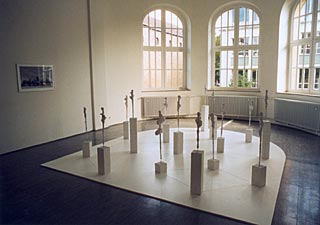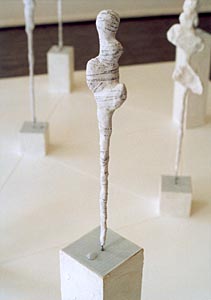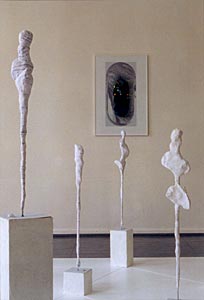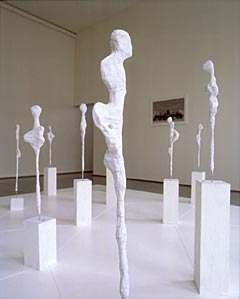|
NOTE
DI SALA / PROGRAM NOTES
ITALIANO
Rosa
Binaria: Memories
Istallazione
interattiva di Alba D’Urbano
Composizione
interattiva esadecafonica di Alessandro Cipriani
Nicolas Reichelt:
sviluppo del software e assistenza tecnica
Jill Luise
Muessig: fotografia

Si tratta
di sedici sculture fatte di rose, carta gesso e suono, disposte
su una piattaforma calpestabile dai visitatori. Le sedici sculture
sono rose vere ricoperte da una carta ingessata sulla quale Ź
scritto in formato ascii la definizione digitale dell’immagine
delle rose stesse. Alle pareti le fotografie delle rose appena
colte, una memoria visibile, mentre il codice ci parla della memoria
digitale. Le rose esposte derivano il loro significato e la propria
aura anche dal fatto che esse portano con sé la testimonianza
dell’esistenza di sedici relazioni umane e di una rete fra esse,
ogni rosa Ź dedicata ad una persona, e quando il visitatore si
avvicina ad essa dalla scultura stessa emergono, a livello sonoro,
due elementi: la registrazione di suoni di un giardino; la voce
dell’artista che racconta della persona in questione, memoria
digitale di una memoria umana.

Photo: Nicolas
Reichelt
Il visitatore
puė attivare e disattivare con il proprio movimento le sedici
voci di questa istallazione esadecafonica, e i racconti, quando
sono attivati insieme, svelano un coro pensato come una rete di
possibili relazioni sonore nello spazio e nel tempo, elaborate
al confine fra poesia e canto ed aperte al gioco attivo del visitatore
che cammina a piedi scalzi sulla pedana…
ENGLISH
Rosa
Binaria: Memories
Interactive
Installation by Alba D’Urbano
Interactive
esadecaphonic composition by Alessandro Cipriani
software development
and technical assistance: Nicolas
Reichelt:
photography:
Jill
Luise Muessig
The sight
of filigree sculptures, installed on pedestals of varying height
and linked at floor level, dominates the exhibition room. Viewed
from close up, the individual objects, apparently covered with
randomly printed strips of paper in plaster, turn out to be mysterious
wrappings. Inside them are concealed various kinds of natural
roses, each wrapped in the ASCII code of their likeness, and petrified
at the point of their natural death, their digital images. Information
about them is provided by the photographs on the surrounding walls,
in which representations of the same roses in their original condition
can be seen.

Thus the exhibition
room appears to the observer to begin with as a rose garden that
can be walked through, but containing frozen, conserved flowers.
Photos: Anne Gold "Memories" is a further part of the project
series "Rosa Binaria" which Alba D'Urbano has been continually
expanding since 1987. A recurrent and central motif in this series
is the rose. For decades, the artist has been collecting rose
objects of all kinds, cataloguing them and systematising them
according to material and origin, and using this archive as the
source of her installations. Many friends and acquaintances have
assisted the artist in her obsession by taking an active part
in the collection. With the installation “Memories” the artist
renders thanks to those involved by personally dedicating a rose
to each of them Thus the work is to be regarded as homage to these
friends and acquaintances. Proverbially, each rose conserves a
personal memory. For as soon as the visitor approaches a rose,
he hears over a built-in loudspeaker the artist's voice, digitally
altered in a different way in each case, giving information in
a brief monologue on the individual and his/her relationship to
the artist. In an experiment with her own memory, Alba D'Urbano
attempts to remember events that took place between a month and
thirteen years ago. The result is a collection of most intimate
rose images.

Photo: Nicolas
Reichelt
Collection,
the primary activity, is followed by arranging, compiling and
exhibiting the roses in the sculptural process. Here, Alba D'Urbano
takes up the basic principles of the museum. By making legacy,
retrospective and museum practice the topic of her contribution
to the exhibition, she draws attention to the central statement
of her work: memory, representing, saving, and reconstructing
her own memories, but also collective memories The exhibited roses
derive their significance and aura from the fact that they bear
witness to the existence of human relations and networks As the
artist presents the roses, arranged in large numbers as a work
of art, the memories of the contexts of life to which the objects
relate are conserved. With the aid of this memory, preservation
also takes place on the artistic level. Art, and with it the museum,
become the storage medium, and assert the claim to be able to
call a halt to time and preserve certain moments in life from
final transitoriness. Using inconspicuous means such as paper,
plaster and sounds, D'Urbano creates a feeling of community. We
are moved, even though not personally affected. Text by Alexandra
Kolossa
TORNA
SU
|



